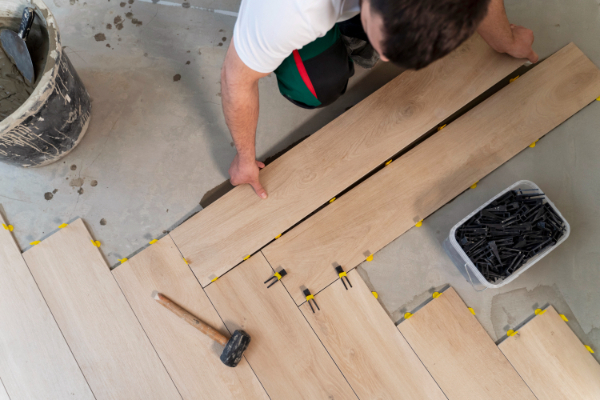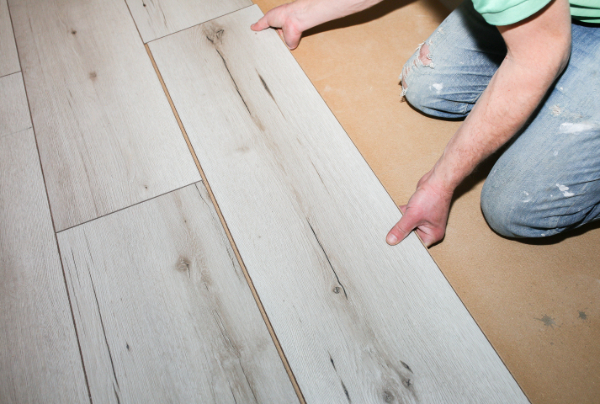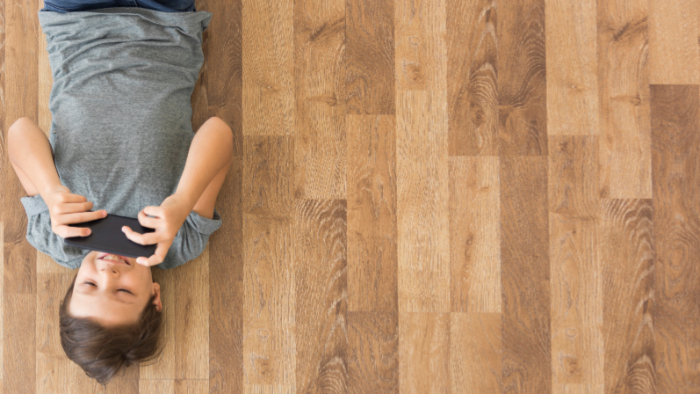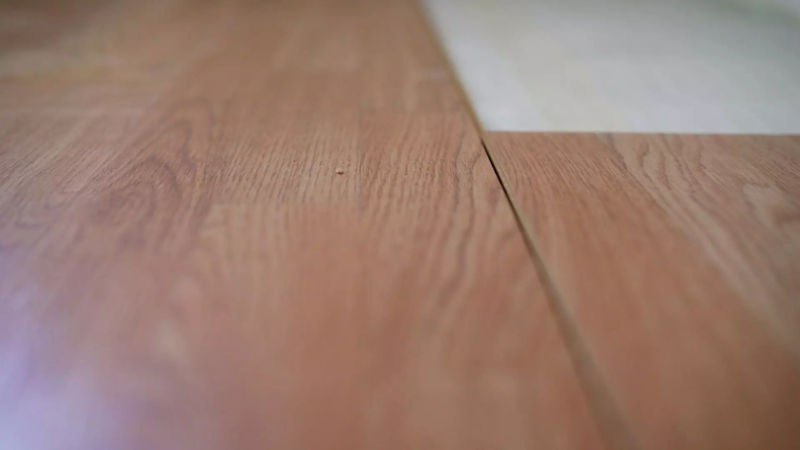This article delves into the world of laminate flooring, exploring its eco-friendly features, benefits, and potential drawbacks. Discover why laminate flooring is gaining popularity as a stylish, cost-effective alternative to traditional hardwood while considering its impact on the environment and its practicality in various home settings.
What Is Laminate Flooring?
Laminate flooring is a widely preferred option in many households, as it provides a synthetic alternative to hardwood flooring while very effectively imitating its appearance. Its multilayered structure and the process of its production give it its unique characteristics and benefits.
The manufacturing process of laminate flooring involves a series of stages called lamination. In this process, different layers are bonded together to form a robust and long-lasting flooring product.
The highest layer, dubbed the wear layer, is a solid, transparent surface that provides a strong defence against scratches and moisture penetration. This not only preserves the aesthetic appeal of the flooring but also ensures its longevity. Below the wear layer is a photographic one, which imitates the look of actual wood. This is how laminate flooring manages to look like real hardwood without the high costs and maintenance requirements.
The third layer in the laminate floor is the core layer, made from high-density fibreboard (HDF). The HDF provides the necessary strength and stability to the flooring, making it resilient and capable of withstanding the pressures of everyday use.
Finally, the back layer, the foundation of the laminate flooring, performs a crucial role in stopping moisture from entering the floor. This eliminates the risk of water damage, making laminate flooring a practical choice for kitchens and bathrooms.
Laminate Is Eco-Friendly
Choosing laminate flooring over other options for your home isn't just a choice based on its visual appeal, but also its role in promoting environmental sustainability as well. The core attribute of laminate flooring which sets it apart is its recyclability. Once it reaches the end of its usage, the components of laminate flooring can be dismantled and repurposed. This process not only diminishes any waste but also supports an economy where resources are continuously reused and recycled.

Furthermore, laminate flooring has a significantly lower environmental impact than traditional wood flooring. In comparison to wood flooring, laminate production requires a considerably smaller number of trees; aiding in the reduction of deforestation. This, in turn, helps in the preservation of key natural habitats, supporting biodiversity.
Additionally, the manufacturing process of laminate flooring is far more energy-efficient than that of traditional wood flooring. Consequently, less pollution is generated both during the production and installation phases.
This commitment to maintaining a lower carbon footprint makes laminate flooring a highly eco-friendly choice, ensuring your home looks great while you contribute to preserving the planet.
Laminate flooring can have a positive impact on the environment compared to hardwood flooring. One of the significant advantages of laminate over hardwood flooring is its ability to resist dust particles, allergens, and microbial contaminants. Moreover, laminate flooring is composed primarily of byproducts from the lumber industry and other recycled materials; this means it makes use of resources that may otherwise be wasted.
In contrast, hardwood flooring often involves the harvesting of old-growth trees, which can have a detrimental effect on forests and wildlife habitats.
For people who want to be mindful of their environmental impact, laminate wood flooring is frequently the better choice. Not only does it have the potential to lower the carbon footprint, but laminate flooring also offers a stylish and durable alternative to traditional hardwood while being more environmentally friendly.
Benefits Of Laminate Flooring
Laminate flooring provides a range of perks to homeowners, a significant one being durability. This type of flooring is exceptionally durable and resistant to regular wear and tear - it can withstand high foot traffic and manage to maintain its new, glossy finish for a long time.
One of the best features of laminate flooring is its convenience when it's installed. Using a simple click-lock design, installing laminate flooring becomes quick and easy. This practical feature is a bonus for DIYers or time-pressed professionals. Maintaining laminate flooring is straightforward and only needs simple sweeping or vacuuming to remove dust and debris.
What also makes laminate flooring a standout is its water-resistant feature; this makes it a superb choice for rooms frequently exposed to moisture, like kitchens or bathrooms.
Additionally, its effortless cleaning capability makes maintaining hygiene in these wet-area rooms a piece of cake. However, you still need to avoid soaking laminate floors during cleaning, as over-saturation could potentially lead to damage.
Disadvantages Of Laminate Flooring
While there are many benefits to installing laminate flooring in your home, it comes with certain downsides that need to be considered. Firstly, despite its moisture resistance, laminate flooring can suffer serious damage if exposed to water for a lengthy period of time; this exposure can result in swelling and deformation, reducing its suitability for parts of the home that regularly have standing water.

Moreover, unlike hardwood floors, which can be effectively restored by sanding down and refinishing, laminate floors do not offer this option.
If a laminate floor gets worn out or damaged, the only solution is complete replacement, which can be a significant investment. Depending on the extent of the damage, this could make laminate flooring a less cost-effective long-term choice for your flooring needs.
Furthermore, unlike wooden flooring that can be sanded down and refurbished, laminate flooring cannot be refinished if it becomes worn down or damaged. In these cases, you have to replace the entire flooring.
In other words, laminate flooring may not be cost-effective as a long-term flooring solution - especially if it needs replacing frequently due to substantial regular wear and tear. Careful consideration should be given before choosing to install laminate flooring, especially for high-traffic or moisture-prone areas within your property.
Laminate Flooring Vs Hardwood Flooring
There are several differences between laminate flooring and hardwood flooring. First and foremost, laminate flooring is generally easier to install compared to its hardwood counterpart; the pieces effortlessly lock together, making the process pretty straightforward and efficient. In contrast, installing hardwood flooring can be quite tedious and might require the help of a professional. In terms of maintenance, laminate flooring wins again.
Laminate is also straightforward to clean, plus it has a higher resistance to stains than hardwood flooring. Therefore, it's perfect for rooms that experience a lot of activity or high traffic, making it both a practical and attractive choice.

On the other hand, hardwood flooring has a significant advantage in terms of its durability. Unlike laminate flooring, which needs a complete replacement if damaged, hardwood flooring can be refinished multiple times.
This means that scratches or age-related wear and tear can be quickly fixed, which substantially extends the life expectancy of hardwood floors. In summation, while laminate flooring provides ease of installation and maintenance, hardwood flooring offers a superior lifespan.
Both laminate and solid hardwood floors have a striking resemblance to one another - however, the resemblance is more pronounced at distant observations. The closer you look at laminate flooring, the more its synthetic nature becomes visible; whereas solid hardwood retains its natural wooden look regardless of proximity.
On the toughness scale, both materials are robust, durable and relatively hard-wearing surfaces. However, the two flooring options are distinguished more by their differences than their similarities. If you want authenticity, increased value and unbeatable durability, then solid hardwood flooring would likely be the better choice. On the other hand, if your budget is a bit tighter, then laminate flooring would be the better fit. While laminate flooring may not fool seasoned eyes into mistaking it for real hardwood, it still acts as a practical and attractive flooring solution for a variety of settings.
Laminate flooring offers an alternative to wooden flooring options. If you are looking for a real wood floor, our timber cutting service can help.
We offer a range of timber cut to size for Manchester, Liverpool, Preston, Oldham, Stockport, Warrington and the surrounding areas.

